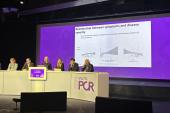Debating a PCI-First Strategy in Stable CAD: ORBITA-2 vs the Unconvinced
In dueling perspectives, experts make their case for and against going with PCI before even trying antianginal medications.

That’s the question at the heart of two perspectives published this week in Circulation: Cardiovascular Quality and Outcomes, with Rasha Al-Lamee, MBBS, PhD, and Christopher Rajkumar, MBBS (Imperial College London, England), making the case for a PCI-first strategy in selected, symptomatic patients based on ORBITA and ORBITA-2.
The greatest benefit of PCI is at the beginning of the treatment algorithm before antianginal medications have eliminated ischemic symptoms, they contend.
Residual symptoms, despite antianginal therapy, from nonischemic causes will not improve with PCI, she added.
I would be the last person to advocate PCI for everyone. We’re just saying that there are patients out there for whom up-front PCI will work. Rasha Al-Lamee
William Boden, MD (Boston University School of Medicine, MA), and Raffaele De Caterina, MD, PhD (University of Pisa, Italy), disagree with that approach, however. A PCI-first strategy for symptom control could “divert attention” away from robust secondary prevention and lifestyle modification that is fundamental for reducing cardiovascular morbidity and mortality, they say.
“The [ORBITA] group have done a lot of unique work looking at the placebo-dependent and independent effects of PCI, but I think they've taken this to a level of almost extrapolation,” Boden told TCTMD. “The two [ORBITA] studies that were conducted were small studies with relatively short follow-up, and while they were able to show some clear indications or benefits for PCI, if you try to put that on the same scale as the large outcomes trials—such as BARI-2D, COURAGE, and ISCHEMIA—that comprise over 10,000 patients [treated with optimal medical therapy], there are vast differences in what you take away from [the data].”
“All we’re talking about here is symptomatic relief,” she said. “I would be the last person to advocate PCI for everyone. We’re just saying that there are patients out there for whom up-front PCI will work.”
In the US guidelines, coronary revascularization is reserved for patients who remain symptomatic despite treatment with antianginal medications. In the newest European guidelines, PCI is a class I (level of evidence A) recommendation to improve symptoms in patients with functionally significant obstructive CAD who have persistent angina or angina equivalent despite guideline-directed medical therapy.
In their perspective, Al-Lamee and Rajkumar argue that the guidelines may be setting PCI up to fail by adopting a strategy of antianginal medication first. In ORBITA-2, which revealed the “unattenuated effect” of PCI without background antianginal therapy, revascularization had a clear benefit on symptoms on the first day after randomization and this symptomatic relief was maintained throughout follow-up.
The researchers argue that while PCI and antianginal therapy tackle angina symptoms in different ways, “the amount of ischemia reduction that is possible in any given patient is finite and may be saturated by effective use of either therapy alone.” At this point, adding other therapies may no longer be effective.
Given the invasiveness of PCI and its associated risks, it should be performed when its able to provide the greatest benefit: at the beginning of the treatment algorithm before the therapeutic window is “saturated” by medical therapy. Offering PCI later rather than earlier “is to offer patients all of the risk, with little reward,” according to Al-Lamee and Rajkumar.
Earlier this year, as reported by TCTMD, the ORBITA-2 researchers showed that stable CAD patients who have angina with typical features are more likely to derive symptomatic relief from PCI. Specifically, those with symptoms captured by the Rose Angina Questionnaire are more likely to experience a reduction in the angina symptom score and number of angina episodes with PCI than those with less typical symptoms.
“Your classic patient that comes to you saying, ‘Over the last 2 months, every time I play tennis, I have tightness in my chest, which goes away when I stop playing.’ That patient probably gets better with PCI,” said Al-Lamee. “I think for those patients you could offer them the procedure up front.”
For those with more atypical symptoms, or patients with a higher burden of comorbidity, antianginal medication first is also an appropriate option. “But you just need to know that PCI at the end of that route will probably have minimal benefit,” said Al-Lamee.
Nonobstructive CAD Is Common
In response, Boden and Caterina argue that a strategy using symptom characteristics to predict PCI’s benefit is too simplistic, adding that atypical angina is more common in women (with and without obstructive disease) and may increase with advancing age. They also point out that not all angina or ischemia results from a coronary obstruction, which may explain why PCI didn’t ameliorate symptoms in the majority of patients in ORBITA-2.
“More than half of patients who have coronary disease don't have obstructive coronary disease,” said Boden, in an interview with TCTMD. “They have microvascular angina or vasospastic angina. If you focus only on stenting the stenotic artery and ignoring medical therapy, or not really emphasizing medical therapy, and don't recognize that nonobstructive causes are common, I think we're going off in the wrong direction. Given the riskiness of [PCI], it’s probably best reserved for people that fail medical therapy rather than as an up-front procedure.”
If you focus only on stenting the stenotic artery and ignoring medical therapy, or not really emphasizing medical therapy, and don't recognize that nonobstructive causes are common, I think we're going off in the wrong direction. William Boden
Recently, Boden along with several international co-authors, proposed renaming coronary syndromes as myocardial ischemic syndromes, further delineating these as acute or nonacute. A nonacute myocardial ischemic syndrome—what is currently called chronic coronary disease or syndromes—would better capture ischemia caused by epicardial coronary stenoses and ischemia caused by nonobstructive coronary arteries (INOCA).
Coronary disease is often “code” for stenosis, which can be misleading given the prevalence of nonobstructive CAD, he told TCTMD.
More broadly, Boden and De Caterina worry about the implications of adopting a PCI-first strategy, pointing out that disease-modifying therapies, such as statins, antiplatelets, renin-angiotensin-system inhibitors, and other medications, may not be adopted if coronary revascularization happens first. Allowing an up-front PCI strategy based on the small ORBITA trials, where patients mostly had single-vessel disease, could be detrimental if these other effective therapies are neglected, according to Boden and De Caterina.
They say: “The concern really is that if we choose to equate symptom [relief] in the short term as the equivalent of a lack of clear event reduction over the long term, are people going to become simply disenchanted with, less committed to, or agnostic to the importance of achieving optimal medical therapy?”
Some Agreement Between Groups
“If you choose to go through with antianginal medication up front, it does take effort and there might be some side effects, along with issues around persistence and adherence,” said Al Lamee. “On the PCI side, there are short- and long-term risks and, of course, a procedural cost. Both have their own pros and cons, but in many places in medicine, we have a conversation about more than one option, and I think it's still okay to do that here.”
In an accompanying editor’s note, Brahmajee Nallamothu, MD (University of Michigan, Ann Arbor), praised both writing groups, stating that the perspectives “go beyond a simple point—counterpoint on PCI’s role in stable CAD” and “raise fundamental questions about how we consider the strengths and standards of evidence that are needed to influence clinical practice.
“They also draw attention to the overall role of uncertainty in clinical decision-making and health policy when it comes to some of our most central arguments,” writes Nallamothu.
Michael O’Riordan is the Managing Editor for TCTMD. He completed his undergraduate degrees at Queen’s University in Kingston, ON, and…
Read Full BioSources
Al-Lamee, Rajkumar CA. Do current clinical guidelines set percutaneous coronary intervention up to fail? Insights from the ORBITA-2 trial. Circ Cardiovasc Qual Outcomes. 2024;17:e011201.
Boden WE, De Caterina R. ORBITA trials are not justification to promote a PCI-first strategy in nonacute myocardial ischemic syndromes. Circ Cardiovasc Qual Outcomes. 2024;17:e011547.
Nallamothu BK. Arguing angina: ORBITA’s challenge to conventional wisdom on PCI. Circ Cardiovasc Qual Outcomes. 2024;17:e011547.
Disclosures
- Al-Lamee reports serving on advisory boards for Janssen Pharmaceuticals, Abbott, and Philips, and speaker’s honoraria: from Abbott, Philips, Medtronic, Servier, Omniprex, and Menarini.
- Boden reports research grant support from the Veterans Affairs Cooperative Studies Program and the National Heart, Lung, and Blood Institute. He has received research funding from AbbVie, Amarin Pharmaceuticals, Amgen, AstraZeneca, and Sanofi-Aventis. In addition, he has received speaking honoraria from Amarin, Amgen, Janssen Pharmaceuticals, Pfizer, and Servier.





Comments